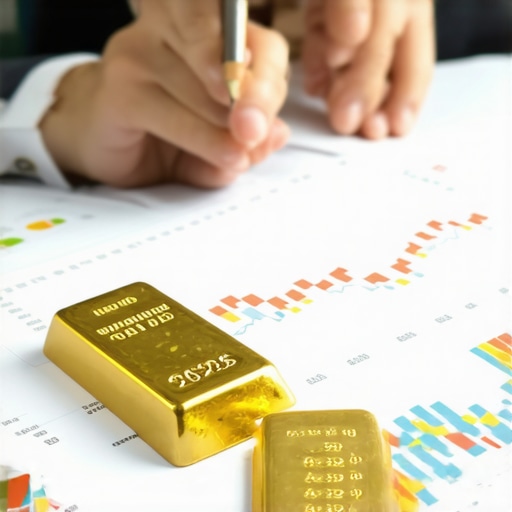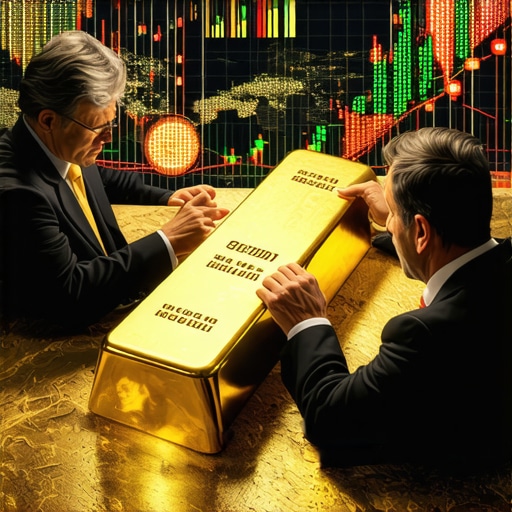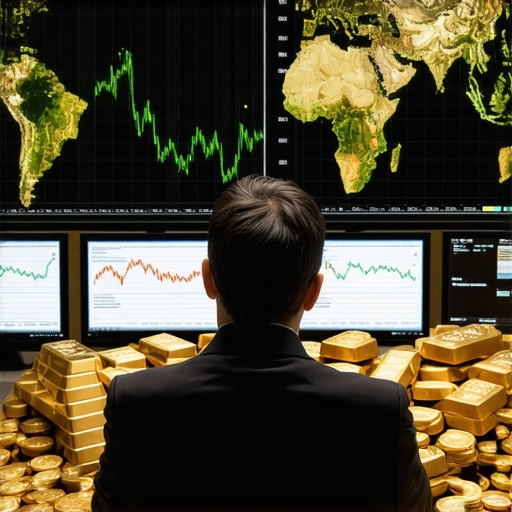Unearthing the Dynamics: What Fuels Global Gold Demand in 2025?
The global gold market in 2025 presents an intricate tapestry woven from diverse economic, geopolitical, and technological threads. Understanding these demand trends requires a discerning eye on how central banks’ reserve policies, investment flows, and consumer behavior intersect. For instance, the surge in gold purchases by emerging economies’ central banks reflects a strategic hedge against currency volatility and inflationary pressures. Meanwhile, retail demand from markets such as India and China continues to be buoyed by cultural affinity and rising disposable incomes.
Technological Innovations and Their Ripple Effects on Gold Consumption
Beyond traditional uses, technological advances in electronics and medical devices are subtly reshaping gold demand profiles. Miniaturization in electronics increases the requirement for high-purity gold, while innovations in nanotechnology open new frontiers for gold applications. Such developments not only diversify demand sources but also introduce complexities in supply chain management and pricing dynamics.
How Do Geopolitical Events Influence Gold Prices and Demand in 2025?
Geopolitical uncertainties remain a critical catalyst for gold’s market behavior. In 2025, tensions in trade relations, regional conflicts, and monetary policy shifts provoke investor flight to safety, often manifesting as increased gold buying. For example, during periods of economic sanctions or political instability, gold often serves as a preferred asset for wealth preservation, driving price spikes. Understanding these linkages allows investors to anticipate market movements more astutely and align their portfolios accordingly.
The Investment Landscape: Gold’s Role Amidst Market Volatility
Amid fluctuating equity markets and persistent inflation concerns, gold continues to be prized as a strategic diversifier and inflation hedge. Sophisticated investors increasingly leverage gold ETFs, futures, and mutual funds to tap into this potential while managing liquidity and risk. These financial instruments offer nuanced exposure options tailored to varying risk appetites and investment horizons, underscoring gold’s evolving role beyond physical bullion.
Supply Constraints and Environmental Considerations: Challenges Ahead
On the supply front, gold mining faces growing challenges from resource depletion and stricter environmental regulations. These factors constrain production growth and introduce price volatility. For example, new mining projects increasingly require sustainable practices and community engagement, elevating operational costs. Consequently, the market must reconcile supply limitations with sustained or growing demand, a dynamic that will shape gold prices through 2025 and beyond.
For readers keen to deepen their understanding, exploring comprehensive analyses of global gold demand trends offers valuable perspectives on how these multifaceted forces interplay.
Engage with this evolving narrative: share your thoughts or questions on how these trends might affect your investment approach in 2025 and beyond.
Authoritative insights for this analysis are drawn from the World Gold Council’s latest reports, which provide empirical data and expert commentary essential for nuanced market understanding (World Gold Council Research).
Personal Lessons: Balancing Gold’s Promise with Market Realities
Reflecting on my own journey with gold investments, I’ve realized that gold isn’t just a static asset; it demands active understanding and strategic patience. Early on, I was captivated by gold’s reputation as a safe haven, but market fluctuations tested my resolve. Over time, blending physical gold holdings with financial instruments like ETFs and mutual funds has offered me flexibility and resilience. This hybrid approach aligns well with gold’s multifaceted role in today’s portfolios, especially amid volatile economic times.
Decoding Market Signals: How to Stay Ahead
One of the most challenging yet rewarding aspects of investing in gold is interpreting the subtle market signals that hint at upcoming shifts. For example, when central banks announce reserve adjustments or when geopolitical tensions simmer, these are often precursors to gold price movements. I find myself constantly watching these indicators, relying on trusted sources like the World Gold Council for comprehensive data and expert analyses. This approach has helped me avoid knee-jerk reactions and instead make informed decisions.
Ever wondered how your personal risk tolerance shapes your gold investment choices?
This question has been pivotal in my investment evolution. Gold offers a unique blend of stability and growth potential, but the best way to incorporate it depends heavily on one’s comfort with risk and investment horizon. For instance, younger investors might favor gold ETFs or mutual funds for liquidity, while those closer to retirement often appreciate physical gold’s tangible security. Reflecting on your own risk comfort can guide whether you lean more towards physical assets or financial products.
The Environmental and Ethical Dimension: A Growing Consideration
As I dug deeper into gold mining realities, I became increasingly aware of the environmental footprint and ethical concerns surrounding extraction practices. Sustainable gold mining is no longer just a buzzword; it’s a critical factor influencing supply constraints and, by extension, prices. Investors today are more mindful, seeking products certified for responsible sourcing. This not only aligns with personal values but may also impact long-term returns as regulatory frameworks tighten.
Sharing Experiences: What Has Your Gold Journey Taught You?
I invite you to share your unique experiences with gold investments. Have you navigated market volatility successfully, or faced challenges that reshaped your strategy? Joining conversations around starting your gold portfolio or advanced tactics can enrich our collective understanding. Feel free to comment below or explore related insights to strengthen your investment approach.
Harnessing Quantitative Analytics: Elevating Gold Investment Strategies Beyond Traditional Models
In 2025, the gold investment landscape is increasingly influenced by the integration of advanced quantitative models that incorporate multifactor analyses, machine learning algorithms, and real-time data feeds. Traditional heuristics based solely on macroeconomic indicators are no longer sufficient to capture the multifaceted drivers of gold prices. Investors are now harnessing predictive analytics that assess the interplay of geopolitical risk indices, currency volatility metrics, and central bank transactional patterns to optimize timing and allocation in gold portfolios.
For example, dynamic hedging strategies utilize stochastic modeling to adjust gold exposure proactively, mitigating downside risk during abrupt market shocks while capitalizing on upward price momentum. This level of sophistication requires not only technical acumen but also a nuanced understanding of market psychology and macro-financial linkages.
How Can AI-Driven Sentiment Analysis Refine Gold Market Forecasts?
Artificial intelligence now plays a pivotal role in parsing vast datasets, including news sentiment, social media discourse, and policy announcements, to gauge investor sentiment and anticipate market trends. By quantifying sentiment shifts around geopolitical events or economic releases, AI models can signal potential spikes or dips in gold demand before traditional indicators react. This approach enhances the precision of forecasting models, empowering investors to navigate the gold market with superior foresight.
According to a detailed study published by the Journal of Commodity Markets, integrating sentiment indices with price models significantly improves the accuracy of gold price predictions, underscoring the transformative impact of AI on commodity investment strategies.
Ethical Investing and the Certification Paradigm: Navigating the Complexities of Responsible Gold Acquisition
As environmental, social, and governance (ESG) criteria take center stage, gold investors face the intricate challenge of aligning financial objectives with ethical considerations. The proliferation of certification schemes such as the Responsible Jewellery Council (RJC) and Fairmined has introduced verifiable standards for responsible sourcing, yet discrepancies and greenwashing risks persist.
Investors must critically evaluate the provenance of gold, scrutinizing supply chain transparency and the tangible impacts of mining operations on local communities and ecosystems. This due diligence extends to understanding the lifecycle emissions and reclamation efforts associated with gold extraction.
Moreover, the intersection of technology and ethics is giving rise to blockchain-enabled traceability solutions that promise immutable records of gold’s origin, fostering enhanced accountability and consumer confidence.
Integrating Environmental Risk Assessments into Gold Price Valuation Models
Incorporating environmental risk assessments into valuation frameworks represents a frontier in gold market analysis. Factors such as carbon pricing policies, water resource management, and biodiversity impact assessments increasingly influence operational costs and production feasibility for mining companies. These elements inject an additional layer of complexity into supply forecasts and, by extension, price dynamics.
For instance, stricter environmental regulations can constrain supply growth, exerting upward pressure on prices, but may simultaneously increase capital expenditure requirements, affecting investor returns. Sophisticated valuation models now embed scenario analyses that simulate regulatory shifts and their cascading effects on supply-demand equilibrium.
Staying ahead of these developments demands continuous engagement with evolving policy landscapes and environmental research.
For those eager to expand their expertise, delving into resources like the World Gold Council’s Sustainability Insights offers a nuanced understanding of these transformative trends.
Engage further by reflecting on how integrating advanced analytics and ethical considerations could reshape your gold investment strategy in 2025 and beyond.
Harnessing AI and Big Data: The New Frontier in Gold Price Prediction
As the gold market evolves amidst mounting complexities, artificial intelligence and big data analytics have emerged as indispensable tools for investors seeking an edge. Beyond traditional economic indicators, these technologies enable the synthesis of vast, heterogeneous datasets—ranging from satellite imagery of mining operations to geopolitical risk assessments—providing a granular understanding of supply-demand dynamics.
Machine learning models can detect nonlinear patterns and subtle correlations that elude conventional forecasting, facilitating real-time portfolio adjustments and enhanced risk management. This paradigm shift underscores the necessity for investors to cultivate technical proficiency and collaborate with data scientists to fully exploit these advancements.
What Are the Challenges and Opportunities of Blockchain in Ensuring Gold Supply Chain Transparency?
Blockchain technology is revolutionizing traceability in the gold industry by creating immutable, decentralized ledgers that document each step of the gold’s journey—from mine to market. This innovation promises to mitigate fraud, combat illicit mining, and bolster investor confidence through verifiable provenance.
Nevertheless, implementing blockchain at scale faces challenges including interoperability between platforms, data input accuracy, and the digital divide affecting mining communities. Despite these hurdles, pilots and consortiums worldwide illustrate the technology’s transformative potential to reconcile ethical sourcing with financial performance.
Integrating ESG and Environmental Risk into Quantitative Valuation Models
Modern gold valuation frameworks increasingly incorporate Environmental, Social, and Governance (ESG) metrics to capture risks and opportunities overlooked by traditional financial models. For example, factoring in carbon emission costs, land rehabilitation liabilities, and community relations can materially alter discounted cash flow analyses and project viability assessments.
This holistic approach aligns with investor mandates for sustainable portfolios and regulatory trends demanding enhanced disclosure. It also encourages mining companies to adopt more responsible practices, ultimately influencing long-term supply stability and market pricing.
For an in-depth exploration of these methodologies, the CFA Institute’s ESG Investing Resources provide authoritative guidance on integrating sustainability considerations into investment analysis.
Embrace these sophisticated insights to refine your gold investment strategy. Engage with emerging technologies and ethical frameworks to position your portfolio at the vanguard of 2025’s gold market innovations.

Frequently Asked Questions (FAQ)
What factors primarily drive global gold demand in 2025?
Global gold demand in 2025 is influenced by a combination of central bank reserve policies, geopolitical tensions, technological innovations, and consumer behavior in key markets such as India and China. Central banks hedge against currency and inflation risks, investors seek safe-haven assets during uncertainty, and technological uses in electronics and medical devices further diversify demand.
How do geopolitical events affect gold prices and investor behavior?
Geopolitical events such as regional conflicts, trade tensions, and monetary policy shifts increase market uncertainty, prompting investors to flock to gold as a safe haven. These events often lead to price spikes as gold is perceived as a stable store of value during economic and political instability.
What role does technology play in shaping gold consumption?
Technological advancements contribute to increased demand for high-purity gold in electronics, nanotechnology, and medical devices. Additionally, AI and big data analytics are transforming how investors predict gold price movements, allowing for more nuanced and timely investment decisions.
How are environmental and ethical considerations impacting the gold market?
Environmental regulations and ethical sourcing standards are increasingly shaping gold supply by constraining mining operations and elevating costs. Certification schemes like the Responsible Jewellery Council and emerging blockchain traceability solutions promote responsible sourcing, reflecting growing investor emphasis on ESG compliance.
What investment vehicles are recommended for gold exposure in volatile markets?
Investors can access gold through physical bullion, ETFs, futures, and mutual funds. The choice depends on risk tolerance, liquidity needs, and investment horizon. Younger investors may prefer ETFs for flexibility, while others may value physical gold for tangible security and inflation hedging.
How does AI-driven sentiment analysis enhance gold market forecasting?
AI sentiment analysis processes vast amounts of data—including news, social media, and policy signals—to anticipate shifts in gold demand before traditional indicators respond. This improves forecast accuracy and helps investors position their portfolios proactively in response to emerging trends.
What challenges exist in implementing blockchain for gold supply chain transparency?
While blockchain offers immutable tracking of gold provenance, challenges include platform interoperability, ensuring data accuracy, and the technological divide among mining communities. Despite these, pilot programs demonstrate blockchain’s potential to reduce fraud and support ethical sourcing.
How are ESG metrics integrated into gold price valuation models?
ESG factors such as carbon emissions, land rehabilitation, and community impact are incorporated into valuation models to better reflect operational risks and costs. This holistic approach influences investment decisions by highlighting sustainability-related risks and opportunities that affect long-term supply and pricing.
Can quantitative analytics improve gold investment strategies?
Yes, integrating multifactor quantitative models, machine learning, and real-time data enhances risk management and timing of gold investments. These tools capture complex market drivers and enable dynamic portfolio adjustments, offering a competitive advantage over traditional heuristic methods.
How should individual investors balance gold’s promise with market realities?
Investors should align gold exposure with their risk tolerance and time horizon, combining physical holdings with financial instruments for diversification. Understanding market signals, ethical considerations, and emerging technologies supports informed decisions and resilience against volatility.
Trusted External Sources
- World Gold Council Research – Provides comprehensive data, market analysis, and sustainability insights essential for understanding gold demand, supply dynamics, and ethical sourcing trends.
- Journal of Commodity Markets – Offers peer-reviewed studies on advanced forecasting models, including AI-driven sentiment analysis, enhancing the precision of gold price predictions.
- CFA Institute ESG Investing Resources – Delivers authoritative guidance on integrating Environmental, Social, and Governance metrics into investment valuation frameworks, relevant for responsible gold investing.
- Responsible Jewellery Council (RJC) – Sets global standards for ethical gold sourcing and certification, informing investors about supply chain transparency and responsible mining practices.
- ScienceDirect (Commodity Market Research Articles) – Hosts in-depth academic research articles on quantitative analytics, blockchain applications, and environmental risk assessments in the gold market.
Conclusion
The gold market in 2025 is characterized by a multifaceted interplay of economic, geopolitical, technological, and ethical factors shaping demand and supply. Investors must navigate this complexity by embracing sophisticated quantitative tools, understanding geopolitical signals, and integrating ESG considerations into their strategies. Technological innovations—from AI-driven analytics to blockchain traceability—are redefining how gold is sourced, valued, and traded, demanding heightened expertise and adaptability.
Balancing gold’s traditional role as a safe haven with emerging market realities requires a nuanced approach that respects both financial objectives and ethical imperatives. By leveraging trusted research, dynamic investment vehicles, and responsible sourcing frameworks, investors can position themselves to capitalize on gold’s enduring value in a rapidly evolving landscape.
Engage with these insights—share your perspectives, explore related expert content, and apply this knowledge to refine your gold investment strategy for 2025 and beyond.











This post provides an insightful overview of how multifaceted the gold demand situation in 2025 truly is. I’ve been particularly intrigued by the increasing role of technological innovations, especially in electronics and nanotechnology, which are subtly reshaping how gold is consumed outside traditional investments. It’s fascinating to see how advancements in AI and big data not only help investors anticipate market movements but also influence operational decisions in gold mining, such as environmental compliance and supply chain transparency. From my experience, staying informed about ESG standards and utilizing blockchain for supply verification has become crucial, given the rising importance of ethical sourcing among investors. I wonder how smaller mining operations can effectively adopt these complex technologies and standards amid cost and resource constraints. What are some practical approaches for companies with limited resources to leverage these innovations without losing competitiveness in the market? Would love to hear others’ perspectives on fostering technological adoption across the entire supply chain.